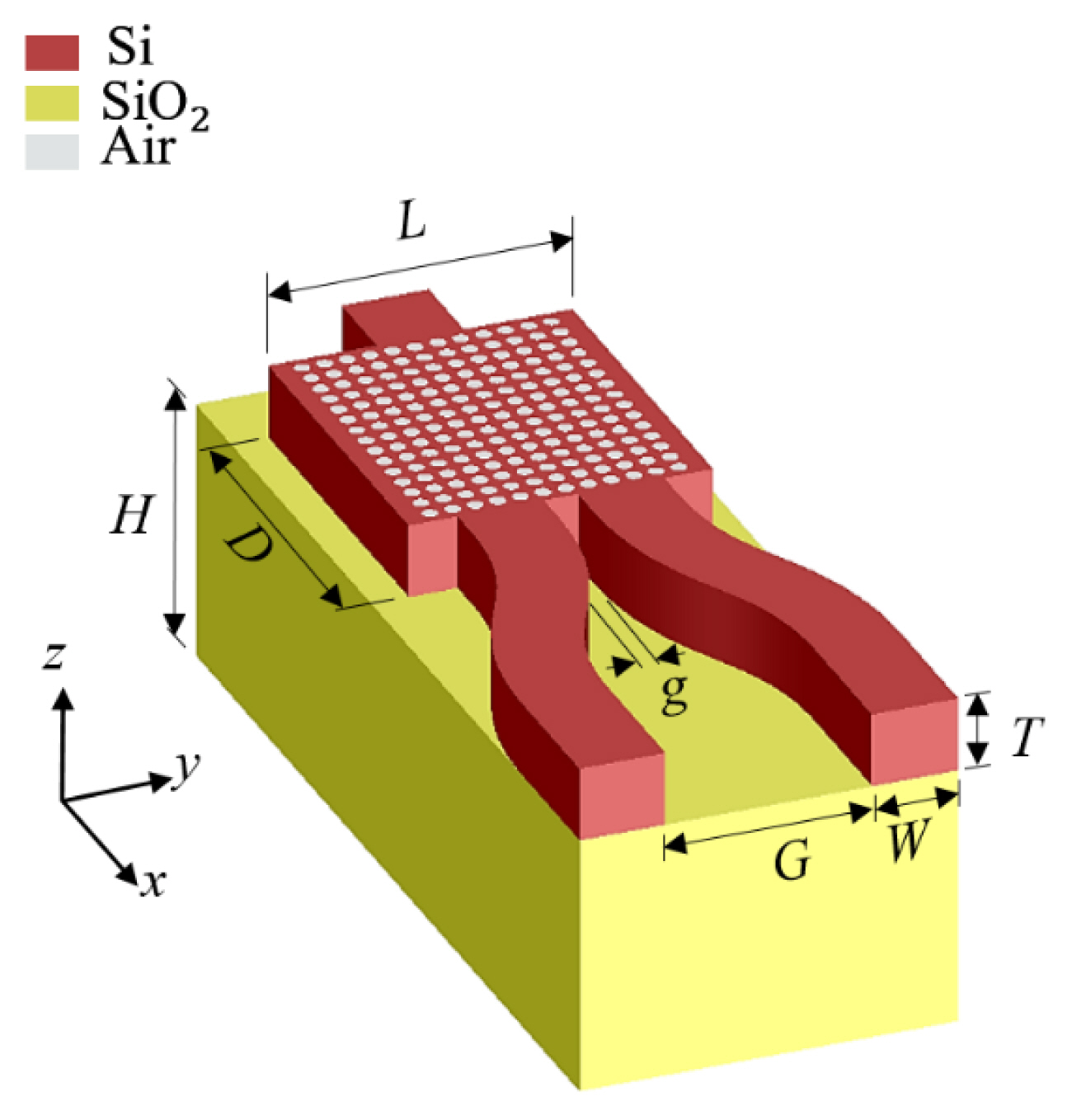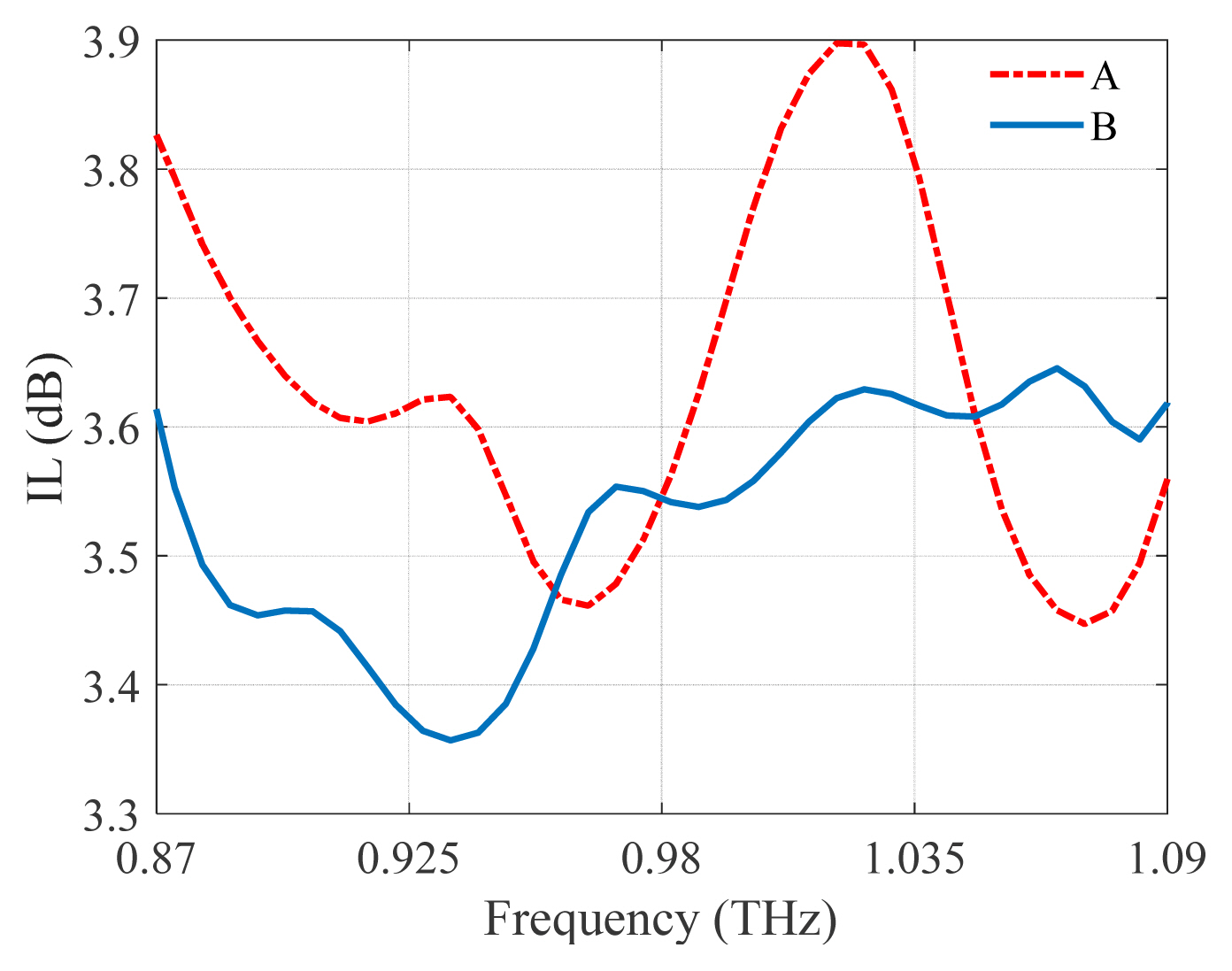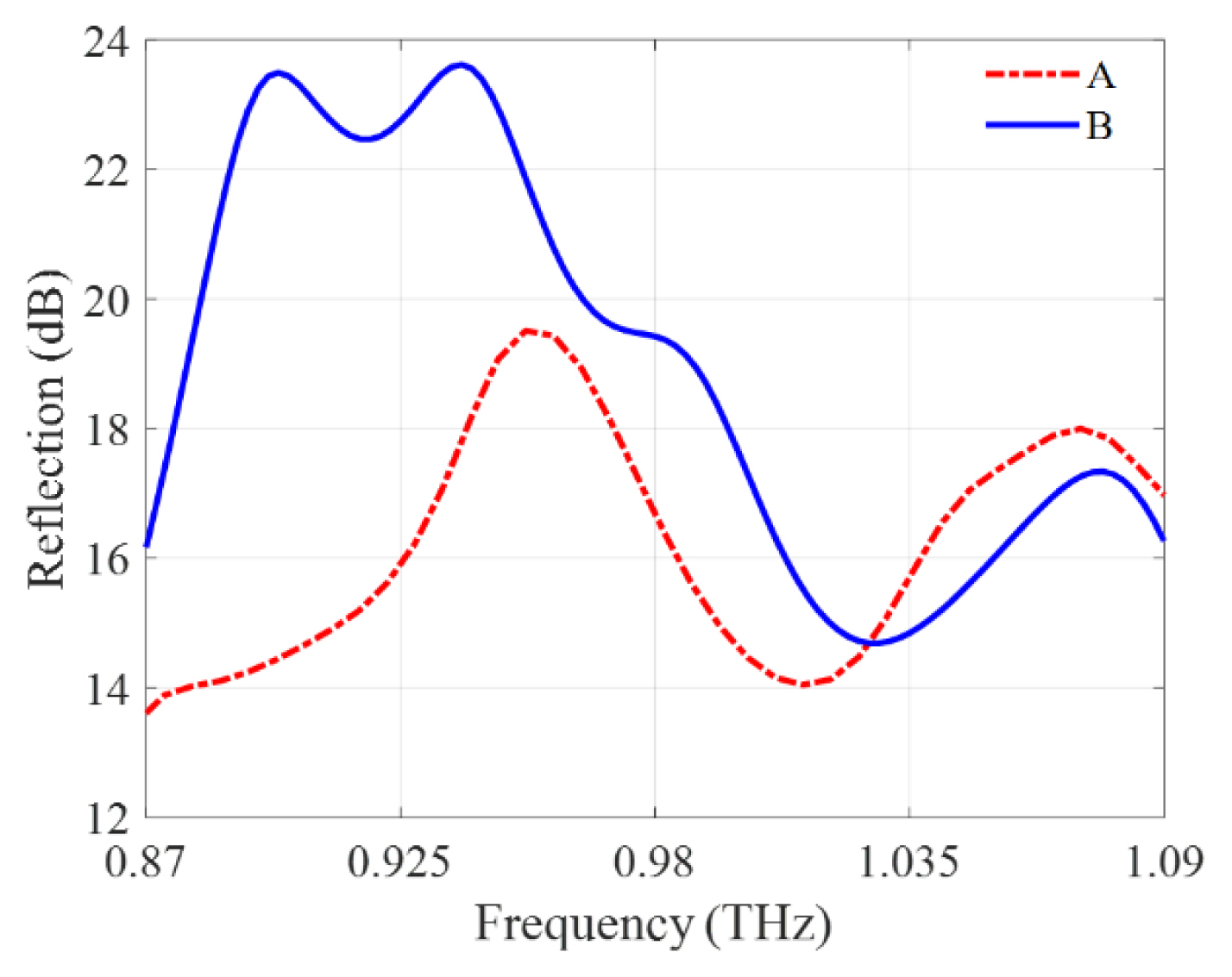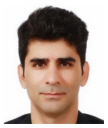I. Introduction
Terahertz technology has attracted considerable attention because terahertz waves can be exploited in wide-ranging applications, including medicine [1–3], security [4, 5], communications [6–8], and spectroscopy [9–11]. Diverse components for manipulating terahertz waves have been designed, including absorbers [12–14], power splitters [15–19], modulators [20–22], polarization power splitters [23–25], and sources [26–30]. Among these components, terahertz power splitters (TPSs) are critically important in integrated circuits for dividing and routing terahertz waves to any point of the circuits. Homes et al. [17] proposed a TPS based on a silicon slab with a thickness of a few millimeters that can be used in spectroscopic measurements over a broad terahertz range (0.2–10 THz). Ung et al. [16] fabricated a TPS by depositing a thin silver sheet on an ultrathin, low-density polyethylene plastic sheet. By changing the thickness of the silver sheet and utilizing its skin depth, they varied the splitting ratios of the TPS, which they achieved through the transmission and reflection of the metallic dielectric structure in a frequency range of 0.5–1.5 THz. Hou et al. [19] proposed a TPS based on ferrite photonic crystals. They inserted line defects in the photonic crystals to steer the light and embedded two silicon and ferrite rods at the output branches to control the variable splitting ratio. In a magnetic field, the refractive index of the ferrite rod changed, and the splitting ratio could be varied. Reichel et al. [18] fabricated a TPS based on T-junction metallic structures. They created metallic waveguides to route the terahertz waves and a mechanical septum that changed the splitting ratio over a frequency range of 0.15–0.3 THz. Yang and Jiu-Sheng [15] realized a 1 × 6 TPS operating at 1 THz using temperature-dependent photonic crystals. By introducing line and point defects into the photonic crystals, they created a multimode interferometer and four Y splitters. However, these TPSs require an external magnetic field, which increases their fabrication cost [19], enlarges their dimensions [15–19], and limits their integrability [16–18].
Designing optical all-dielectric components is of great importance due to their low loss and high efficiency [31–35]. In this letter, we present compact all-dielectric TPSs with an ultra-small footprint that are compatible with CMOS (complementary metal-oxide-semiconductor) fabrication technology. The TPSs were designed from metamaterials using an inverse design process based on particle swarm optimization (PSO), which optimizes the structures in a 50:50 splitting ratio. The finite-difference time-domain (FDTD) module of Lumerical software (Ansys, Vancouver, Canada) was used to simulate the structures.
II. Simulation Results and Discussion
The devices have digitized structures made of a silicon slab with air holes deposited on a buried silicon dioxide substrate. They contain one input and two output waveguides, as shown in Fig. 1.
When designing a device using the PSO method, an initial structure is needed. The initial digitized structure consisted of a silicon (Si) slab etched with air holes deposited on a SiO2 substrate (Fig. 1). The radius of the air holes and the array period were 9 μm and 26 μm, respectively. The parameters L, D, H, G, g, W, and T (see Fig. 1 for their geometric descriptions) were set to 350, 400, 1,000, 237.6, 39.6, 100, and 100 μm, respectively. The region to be optimized was the region containing the circular holes, with dimensions of L × D × T. In this structure, the air holes were modeled as 1, and the silicon was modeled as 0. The insertion loss (IL), which is defined as −10log (Po/Pin) (where Po and Pin are the output power at the upper or lower branch and the incident power, respectively), was considered the figure of merit of the proposed device, which was minimized using the PSO method.
The structure was simulated using the three-dimensional (3D) FDTD method. The generation size and maximum generation number of the PSO method were 10 and 100, respectively. The mesh size of the 3D FDTD was dx = dy = dz = 3 μm. The waveguides were excited by a TE00 polarization mode with the electrical field component in the y-direction. The working frequency range of the device was 0.87–1.09 THz. Within this frequency range, the refractive indices of Si and SiO2 are 3.41 and 1.96, respectively.
Fig. 2 shows the structures after optimization using the PSO-based inverse design method. After optimization, a few circular air holes with optimized positions remained in the silicon slab on the SiO2 substrate. The inset of Fig. 2(a) displays the electromagnetic power distribution of the TE00 incident polarization mode at the cross-section of the input waveguide. The air holes in the optimized structure act as scatterer points. Aided by constructive interferences in the optimized region, the light is routed to the output branches. Moreover, these holes create a photonic bandgap that prevents the terahertz waves from diffracting in the y-direction; consequently, light can be guided only through the output branches. The sparsity of holes in the optimized region creates a guiding electromagnetic mode in the bandgap that steers the light to the outputs. Furthermore, using air holes with two different radii provides freedom for constructive interferences that result in higher transmission from the optimized digitized structure. Fig. 2(a) shows the optimized digitized structure containing air holes with a radius of 9 μm, and Fig. 2(b) shows the structure containing air holes with two different radii in the silicon slab.
Fig. 3 shows the IL of the optimized 50:50 TPS structures containing air holes with one radius (structure A) and two different radii (structure B). The ILs of structures A and B were less than 3.9 dB and 3.65 dB, respectively, indicating efficiencies of approximately 81% and 86%, respectively, over a frequency range of 0.87–1.09 THz. Thus, structure B had higher efficiency than structure A. Moreover, the IL of structure B over this frequency range was flatter than that of structure A. The electromagnetic power distributions of the optimized structures A and B at a frequency of 0.94 THz are shown in Fig. 4(a) and 4(b), respectively. The distributions show the routes of the terahertz light in the optimized structures.
PSO is a bio-inspired stochastic algorithm for finding the optimal solution over the solution space. This optimization method has been used to design photonic devices [36, 37]. In this work, the PSO algorithm was used to minimize the IL. In this algorithm, N particles are considered, and Xi = (xi1, xi2, xi3, …, xid, …, xiD), Vi =(vi1, vi2, vi3, …, vid, …, viD), Pi =(pi1, pi2, pi3, …, pid, …, piD), and Pg =(pg1, pg2, pg3, …, pgd, …, pgD) are the position, velocity, optimal position, and swarm’s optimal position at each particle, respectively. D represents the dimension of the space that stands for the number of air holes inside the silicon slab. The velocity and position of particles at each iteration t are defined as
where r1 and r2 are random numbers on the interval [0, 1], and c1, c2, and ω are social, cognitive, and inertial parameters, respectively. As shown in Fig. 5(a) and 5(b), the ILs converged roughly after 63 iterations, and the IL of structure B was less than that of structure A owing to the use of air holes with two different radii (7 μm and 9 μm). The IL parameter versus particles and iterations for the two structures is shown in Fig. 5(c) and 5(d). The IL decreased abruptly and then showed a further gradual decrease over iterations. The simulation time taken to design each structure using the PSO on a PC with a 2.9 GHz Core-i7 CPU and 32 GB of RAM was roughly 20 hours.
To show the return loss of structures A and B, the reflection at the input is defined as −10log(PRef/Pin), where PRef is the reflection at the input port. The reflection for the two structures is shown in Fig. 6. The reflection for structure A was higher than that of structure B over almost the entire working spectrum.
III. Conclusion
In this letter, we presented two 50:50 TE TPSs based on digitized metamaterials. The devices contain an input and two silicon waveguide outputs and were optimized using the PSO inverse design method. The structures consist of a silicon slab etched with a few air holes and deposited on a SiO2 substrate. The ILs of the optimized devices containing air holes with one radius and air holes with two different radii were less than 3.9 dB and 3.65 dB, respectively, over a frequency range of 0.87–1.09 THz. The advantages of the devices are compactness, efficiency, small footprint, all-dielectric properties, and compatibility with CMOS fabrication technology. These devices are suitable candidates for high-density terahertz circuits.



















